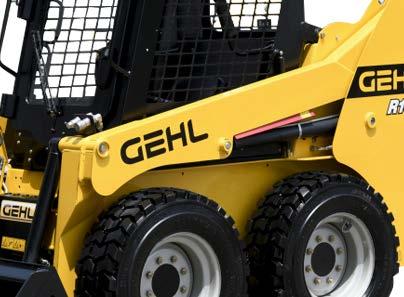
3 minute read
Attachment Mounting
The GEHL loader is equipped with a two-pin All-Tach™ attachment bracket for mounting a bucket or other attach-ment. Two latch levers secure the attach-ment. Rotate the levers until they are hori-zontal to engage the latch pins. Rotate the levers until they are vertical to disengage thelatchpins.
To prevent unexpected attachment release from the hitch, be sure to secure the lock pins by rotating the levers downward into a horizontal position.
Warning
Chapter 4 Operation
Before starting the engine and operating the loader, review and comply with all safety recommendations in the Safety chapter of this manual. Know how to stop the loader before starting it. Also, be sure to fasten and properly adjust the seatbelt and lower the operator restraint bar.
Before Starting the Engine
Before starting the engine and running the loader, refer to the Controls and Safety Equipment chapter and familiarize yourself with the various operating controls, indicators and safety devices on the loader.
Starting the Engine
The following procedure is recommended for starting the engine:
1.Carefully step up onto the back of the bucket or attachment and grasp the ROPS handholds to get into the operator’s compartment.
2. Fasten the seatbelt and lower the restraint bar.
3. Verify the following: the lift/tilt, drive and auxiliary controls are in their neutral positions, the brake is on.
4. Push the throttle forward to half speed.
Note: When the key is turned to the RUN position, an indicator will light on the instrument panel and a buzzer will sound momentarily to remind you to check that your seatbelt is fastened.
5. Turn the keyswitch to the START position.
Important: Do not engage the starter for longer than 15 seconds at a time. Longer use can overheat and damage the starter. Allow the starter to cool for 20seconds between uses.
After the engine starts, allow a sufficient warm-up time before attempting to operate the controls.
Important: If the warning lights do not go off, stop the engine and investigate the cause.
Cold Starting Procedure
Warning Warning
Do not use starting fluid (ether) with preheat systems. An explosion can result which can cause engine damage, injury or death.
1.Turn the key to the run position. If the preheat light on the right instrument panel comes on, wait until it goes out.
2. Turn the key switch to the start position.
3. Repeat if engine does not start.
Stopping the Loader
The following procedure is the recommended sequence for stopping the loader:
1.Check that the drive control handle(s) is (are) in “neutral” position.
2. Lower the lift arm and rest the attachment on the ground.
3. Pull the throttle lever back to the low idle position (and/or take your foot off the accelerator pedal for hands-only controlled machines).
4. Turn the keyswitch to the OFF position to shut off the engine.
5. Raise the restraint bar, unfasten the seatbelt and grasp the hand holds while climbing out of the operator’s compartment.
Note: The skid-steer loader is equipped with a spring-applied automatic parking brake. The parking brake is engaged when the operator lifts the restraint bar, leaves the operator’s seat, shuts off the engine or when the brake switch is applied.
Parking the Loader
Park the loader on level ground away from traffic. If this is not possible, park the loader across the incline and block the tires to prevent movement.
Jump Starting the Engine
If the battery becomes discharged or does not have enough power to start the engine, use jumper cables and the following procedure to jump-start the loader engine.
The ONLY safe method for jump starting with a discharged battery is for TWO PEOPLE to perform the following procedure. The second person removes the jumper cables so that the operator does not have to leave the operator’s compartment with the engine running. NEVER make jumper cable connections directly to the starter solenoid of either engine. DO NOT start the engine from any position other than on the operator’s seat and then ONLY after being sure ALL controls are in “neutral”.
Closely follow the procedure, in order, to avoid personal injury. In addition, wear safety glasses to protect your eyes and avoid leaning over the batteries while jump-starting.
DO NOT jump-start the battery if it is frozen, because it may rupture or explode.
Note: BE SURE the jumper battery is a 12-volt D.C. battery.
1.Turn the keyswitches of both vehicles to OFF, be sure the vehicles are in “neutral” and NOT touching each other.
2.Connect the positive (+) jumper cable to the positive (+) battery terminal on the disabled loader first. DO NOT allow the positive clamps to touch any metal other than the positive (+) battery terminals.
3.Connect the other end of the positive jumper cable to the jumper vehicle’s battery positive (+) terminal.
4.Connect the negative (-) jumper cable to the jumper vehicle’s battery negative (-) terminal.
5.Make the final negative (-) jumper cable connection to the disabled loader’s engine block or loader frame (ground) – NOT to the disabled battery’s negative post. If connected to the engine, keep the jumper clamp away from the battery, fuel lines and moving parts.
6.Start the loader. If it does not start at once, start the jumper vehicle engine to avoid excessive drain on the booster battery.
7. After the disabled loader is started and running smoothly, have the second person remove the jumper cables (negative (-) jumper cable first) from the jumper vehicle’s battery and then from the disabled loader while being sure NOT to short the two cables together. Allow sufficient time for the skid-steer loader alternator to build-up a charge in the battery before attempting to operate the loader or shut the engine off.






